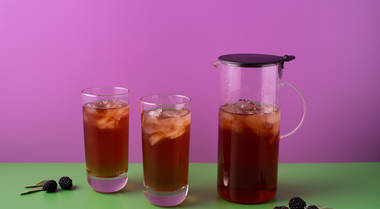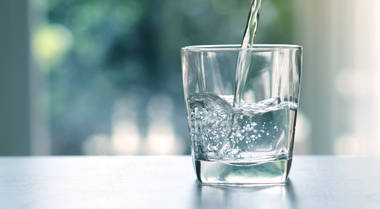Water Review: Filtered Water, Reverse Osmosis, Spring Water
August 13, 2025

Why Water Deserves More Attention
You've picked the perfect tea, steeped it at the right temperature, and timed it to the second. But if the water you're using isn't up to par, you might still end up with a lackluster cup.
It's easy to forget that water isn't just the background player in tea, it's the whole stage. In fact, it makes up more than 95% of your brew. So when water quality is off, even the finest teas can lose their nuance and character.
In this guide, we're diving into the role water plays in the flavor, texture, and overall experience of tea. We'll break down what's in your water, how it can help (or hurt) your brew, and simple ways to get the most out of every sip.
What's Actually in Your Water?
Not all water is created equal, and that matters more than you might think.
Most tap water contains a mix of minerals and additives. Some of these can enhance flavor; others can interfere with it. When people talk about "water quality," they're usually referring to the water's taste, clarity, and chemical makeup. Here are a few key components you might find:
- Minerals like calcium and magnesium give water "hardness." A little can help bring out flavor in tea, but too much may cause bitterness or cloudiness.- Chlorine or chloramine are added to municipal water systems to kill bacteria, but they can add a sharp, chemical flavor that clashes with delicate teas.
- Total dissolved solids (TDS) is a measure of everything in your water: minerals, salts, and other substances. The higher the TDS, the more likely your tea's flavor will be affected.Even from city to city (or neighborhood to neighborhood) water quality can vary. That's why your favorite tea might taste one way at home and totally different elsewhere.
How Water Composition Affects Tea Flavor
If you've ever brewed the same tea in different places and thought, "Why does this taste weird?", chances are the water is to blame.
Hard water (with high levels of minerals) can flatten or muddy the flavors of tea, especially those that are more delicate like green or white teas. Some teas may even develop a slightly metallic or chalky aftertaste.
Soft water, on the other hand, can be too "neutral," leaving the tea tasting thin or underwhelming. The trick is finding a balance—just enough minerals to enhance flavor, without overwhelming it.
Then there's chlorine, a common culprit behind that pool-like smell or taste you might notice in tap water. While harmless in small amounts, it can mute aromas and interfere with the subtleties of complex teas.
Some teas are more forgiving. Bold black teas or herbal blends may still taste fine with tap water. But if you're sipping a nuanced oolong or a grassy sencha, you'll want water that supports (not distracts from) their delicate profiles.
Types of Water and How They Stack Up
Let's look at some of the most common types of water people use for tea, and how they affect the brew:
Tap Water: Convenient and free (or close to it), but inconsistent. Depending on where you live, it may be too hard, taste strongly of chlorine, or both. Filtering it can help a lot.
Filtered Water: Often the best balance between convenience and quality. A simple carbon filter can remove chlorine and reduce excess minerals without stripping water of everything good.
Bottled Spring Water: Usually a good choice, since it often has a balanced mineral content and a clean taste. The downside? It can get pricey, especially if you drink tea daily. And of course, the environmental impact can stack up quickly if you're using it every day.
Distilled or Reverse Osmosis Water: These are ultra-purified and contain virtually no minerals. They're great for lab work, not so great for tea. Without minerals, the tea may taste flat or dull. What you want is water with moderate mineral content, a neutral pH, and no off smells or chemical aftertastes. If the water tastes good on its own, it's probably good for your tea, too.

Simple Ways to Improve Your Tea Water
The good news? You don't have to install a fancy water system or buy expensive bottled water to upgrade your tea game. Here are a few practical steps:
Use a filter. A basic pitcher filter or faucet-mounted filter can remove chlorine and reduce mineral buildup. It's one of the easiest, most cost-effective ways to improve your water quality.
Let it breathe. If you don't have a filter, try letting tap water sit out for 10–15 minutes before boiling. This allows some of the chlorine to evaporate naturally.Taste test. Brew the same tea with different waters (tap, filtered, spring) and compare. You'll be surprised how much the water changes the flavor.
Check your local water report. Many municipalities provide this online. You can learn about your area's mineral levels, chlorine content, and whether filtering is necessary.
For the especially curious, a TDS meter (available online for under $20) can give you a rough idea of how much is dissolved in your water. Many tea experts recommend water with TDS around 50–150 ppm for optimal brewing.
Your Cup Starts at the Tap
Tea is all about subtlety and balance. And since water makes up nearly your entire cup, it deserves just as much attention as the leaves themselves.
By understanding what's in your water and making a few simple tweaks, you can unlock more flavor, aroma, and clarity from every tea you brew. Whether you're a seasoned connoisseur or just starting your tea journey, adjusting your water is one of the easiest ways to make a noticeable difference to your cup.
So next time you make a pot of your favorite blend, don't just ask, "What tea should I brew?" Ask, "What water am I using?"
You (and your taste buds) will notice the difference.